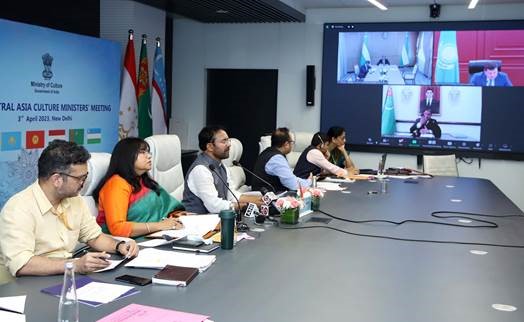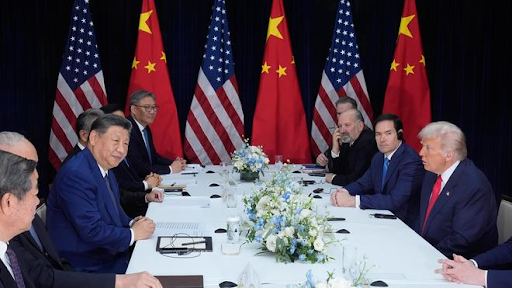Description

Disclaimer: Copyright infringement not intended
Context
- Minister of Culture G. Kishan Reddy hosted the first India-Central Asia Culture Ministers’ Meeting through video conferencing.
Details of the meeting
- The Culture Ministers of Kazakhstan, Kyrgyzstan, Tajikistan, Turkmenistan and Uzbekistan participated in the meeting.
- The India-Central Asia Summit hosted by Prime Minister Modi in 2022 had laid emphasis on promoting cultural cooperation.
- Leaders resolved to promote cultural cooperation for better understanding of culture between the Central Asian countries and strengthening age-old cultural linkages of the region.
- Indian minister spoke about the historical and cultural linkages of India and Central Asia.
- The Minister referred to the eternal teachings of ahimsa or non-violence preached by Buddha.
- He stated that shared Buddhist heritage is a cherished spiritual bond which needs to be further cultivated and propagated for harmonious relations.
.jpeg)
A brief on the relations
History and Geopolitical Importance
- India has historical, cultural and religious links with Central Asia dating back to more than two millennia.
- The spread of Buddhism from India, the Silk route linkages of Bukhara and Samarkand, the Kushana empire commonality, spread of Sufism and Islam, arrival of Babur and many more such linkages are indicative of the deep-rooted relationship.
- The ancient silk route not only connected the region but also connected its people through trade, culture, religion and commerce.
- After the breakup of the Soviet Union in 1991, the countries of Central Asia emerged as independent nations. Central Asia as we know today comprises of five countries – Kazakhstan, Kyrgyzstan, Tajikistan, Turkmenistan and Uzbekistan.
- The region was part of India’s ‘Extended Neighbourhood’ foreign policy enunciated in 2001, along with South Asia and SE Asia.
- While our engagements with South and SE Asia showed a perceptible rise, our engagements with CAR remained hesitant. This could be attributed to following reasons:
- Lack of geographical land borders with Central Asia.
- Inability to have a land route either through Pakistan-Afghanistan or India-China borders.
- Instability in Afghanistan.
- Lack of finances to invest in infrastructure and development projects.
Importance of the Region to India
To India, unhindered access to CAR region is important because of the following reasons:-
-
- As an alternate source of fuels for energy.
- As a consumer market for its finished goods.
- Counter the influence of China and Pakistan in the region.
- Faster and cheaper connectivity to Europe and West Asia.
- Prevent proliferation of terrorism and radical Islam.
- Strengthen historical cultural and religious bonds

Connectivity Initiatives
- The widely discussed alternate strategy to access Central Asia from India is through the sea to Chabahar port in Iran and from there to Central Asia using the road/rail link through either Iran or Afghanistan, skirting Pakistan.
- The prime mover of this strategy is the International North-South Transport Corridor (INSTC).
- It is a 7,200 km long multi-modal network of ship, rail and road-based linkages for the movement of freight and cargo between India, Iran, Afghanistan, Armenia, Azerbaijan, Russia, Central Asia and Europe.
- Since 2016, India is a member of the Ashgabat agreement which is a multi-modal transport agreement between India, Iran, Kazakhstan, Oman, Turkmenistan and Uzbekistan for creating an international transit corridor for the transportation of goods between Central Asia and the Persian Gulf.
- Another long-term strategy is the 1,800 km long Turkmenistan-Afghanistan-Pakistan-India (TAPI)pipeline which when commissioned will be a key milestone in connecting energy-rich Central Asia with energy-starved South Asia.
Energy
- India imports about 77% of its energy needs. Most of the imports are from OPEC countries. So, India is trying to diversify its imports in which effort, Central Asia can be an important source.
- Kazakhstan produces 43% of world’s Uranium.
- Uzbekistan has large reserves of gas, uranium and gold. It is one of the biggest uranium exporters in the world.
- India has signed agreements with Kazakhstan and Uzbekistan for the supply of uranium to feed its nuclear reactors and our nuclear power plants.
- India and Uzbekistan have signed agreements on joint exploration and exploitation of Uzbek gas fields and to assist in the construction of liquid gas and oil factories in Uzbekistan.
- Turkmenistan is home to world’s fourth largest gas reserves, a fuel which is less carbon intensive.
- In Kyrgyzstan, 90% of power generation capacity from hydel sources remains untapped.
- India can develop power grids across CAR.
- Also, India with its expertise in development of hydro projects can transfer technology to assist upper riparian states in hydel power technology.
Defence and Security Cooperation
- Cooperation in the field of Defence and Security is important because India and Central Asia share a common interest in the stability of Afghanistan.
- It is also due to the fact that while Russia remains the key security provider in the region, China is slowly stepping up its security activities in the region.
- Besides providing India with a key role in the extended neighbourhood and an eye on the Taliban activities in Afghanistan and Chinese activities in Central Asia, security cooperation and multilateral security exercises with Central Asian countries under the SCO framework provides India an avenue for engagement with China and Pakistan.
Trade
- India is an emerging market economy whereas Central Asian countries are modest economies, which rely on international trade for many of their needs.
- As a result, trade between India and Central Asia has great potential.
- India’s trade with Central Asia is about $2Bn compared to China’s $60 Bn.
- Indian imports are precious stones, chemicals, iron and steel, machinery, mineral oil, copper goods, plastic goods, wool, and leather.
- Indian exports are essentially coffee, tea, spices, apparel, pharmaceuticals, and electrical and mechanical equipment. If we see the trade, all are low-value items. There is much scope for high-value items.
- Central Asian countries are themselves looking to diversify from their over-dependence on China and Russia. Central Asia is looking towards India as a market and a supplier.
Developmental Assistance
- Central Asia and India’s developmental cooperation is focused on the Lines of Credit provided by India to finance developmental and infrastructure projects.
- The Indian Technical and Economic Cooperation (ITEC) programme which commenced in the early 1990s is very popular in Central Asia.
- India has launched community development projects in several Central Asian countries through tool room training centres imparting skill-based training to locals.

Current Status of the relations
- Since PM Modi’s visit to Central Asia in 2015, there has been an impetus of Central Asia in our foreign policy.
- One of the important initiatives has been the India-Central Asia Dialogues.
- In the first dialogue in Samarkand in Jan 2019, India proposed setting up of ‘India-Central Asia Development Group’, air corridors with India, and participation of Central Asian countries in the Chabahar project.
- In the 2nd dialogue in October 2020, India announced a $1 Bn Line of Credit for infrastructure and connectivity projects in Central Asia.
- The third edition of India-Central Asia dialogues was held in December 2021. The key points of the meet was on usage of INSTC, development of regional connectivity through Chabahar port, developing transit and transport potential and establishing joint working groups on free movement of goods and services.
- An India-Central Asia summit meeting was held in January 2022. In the meeting PM Modi offered to improve India’s connectivity and trade ties with the area, as well as develop people-to- people exchanges.
Way Ahead
CAR countries and India have not optimally utilized each other’s potential in many sectors. Some recommendations for the future are:
Leveraging Iran-China Relationship
- Iran shares cordial relations with both India and China.
- An Iran-India-China trilateral agreement for transportation of oil and gas from Iran and CAR will be a win-win strategy for all partners
Military Bases
- India spent close to $70 Mn between 2002-10 to renovate its military bases in Ayni and Fakhror in Tajikstan.
- Both these bases are now closed.
- With the US withdrawal and takeover of Afghanistan by Taliban, there is a distinct possibility of instability in the region.
- India needs to engage more closely with Russia to secure a military base in the region. Such a base is necessary to counter the increasing Chinese military footprints in the region.

Engagement with Taliban and Cooperation on Terrorism
- Despite apprehensions, India may not have an option but to engage with Taliban in the long term.
- An engagement with Taliban is essential for India’s connectivity and Central Asian Region markets.
Food Security
- This is an emerging problem in the Central Asian states especially due to the Russia-Ukraine war.
- India should utilise this opportunity not only from a trade perspective but also for enhancing its goodwill in the respective countries.
- Any surplus food grains can be exported to Central Asian states at subsidised rates to tide over any food crisis in Central Asia.
Joint Ventures and Infrastructure Partnerships
- India has shown itself to be an alternative to China’s BRI in South Asia, and, therefore a potential partner in Central Asia.
- Multi-lateral partnerships with Central Asian States in the fields of Space, Aeronautics, Satellite technologies, AI, Nano-Technology, Data Analytics, Renewable Energy, Water Conservation, Pharma, Defence Manufacturing, Military Tech, and Counter Terrorism can be forged.
Financial Partnerships through a regional common Central Asian market
- There is a requirement to invest in a common Central Asian market for very long.
- There is a need for a Free Trade Agreement (FTA) between India and the Eurasian Economic Union (EEU) which has a potential of spurring the trade several notches from the present 10 Billion US dollars.
Air Corridor
- The Indian EAM has suggested an air corridor between Central Asian countries and India during his address to Central Asian Business Forum in Feb 2020.
- Such a corridor would be invaluable especially for ‘high value-low volume’ items of trade between the countries.
Soft Power Initiatives
- Ventures such as ‘friendship hospitals’ in each of the central Asian country, exchanging information and cooperating in counterterrorism, technical and financial help in the establishment of cooperatives and self-help groups, promoting educational exchanges, medical training, and, encouragement of Indian Ayurvedic and Unani medicines can go along way in deepening the relationship by making the Indian presence inevitable in the CAR.
|
PRACTICE QUESTION
Q) CAR countries and India have not optimally utilized each other’s potential in many sectors. Examine the validity of this statement. Suggest recommendations for the future to tap the full potential of India-Central Asia Relations. (250 words)
|

https://www.pib.gov.in/PressReleasePage.aspx?PRID=1913362









